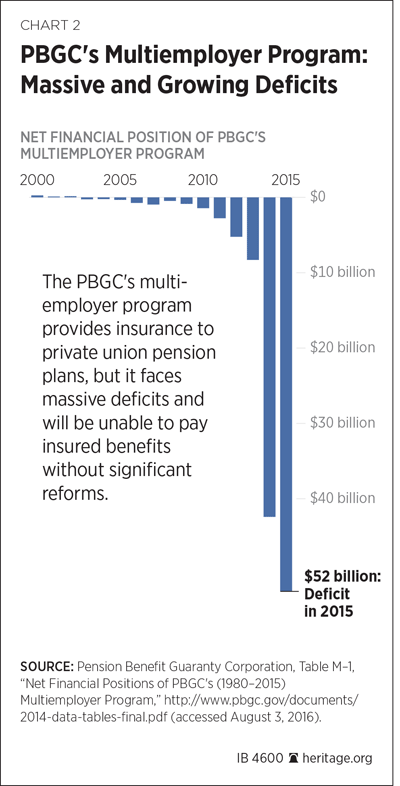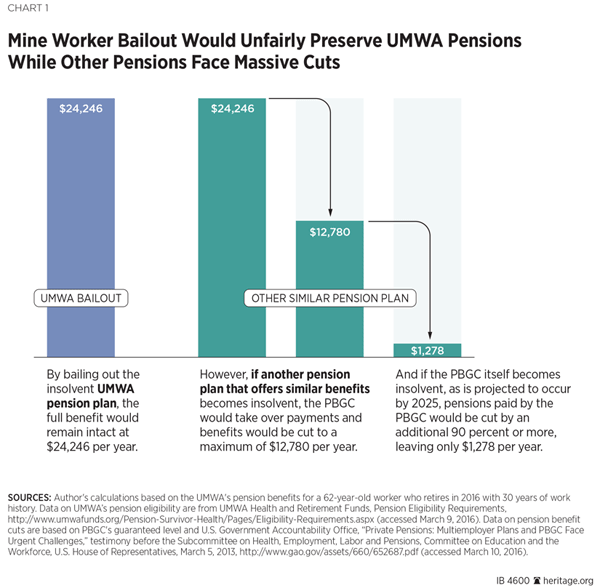Congress is looking to pass legislation that would use taxpayer dollars to bail out the overpromised, underfunded pension plan of the United Mine Workers of America (UMWA). Such an unprecedented move would send the message that Congress will stand behind sending trillions of dollars in overpromised, underfunded public and private pension obligations across the country. The federal government already provides a backstop for failed union and other private pension plans by insuring them through the Pension Benefit Guaranty Corporation (PBGC). Congress should avoid bailing out select pension plans at all costs and should instead reform the PBGC so that it can meet its obligations without a taxpayer bailout.
Coal Miner Bailout Just Tip of the Iceberg
The UMWA pension plan is massively underfunded. It has promised $5.6 billion more in pension benefits than it will be able to pay.[1] Although the UMWA pension plan is among the worst-funded pension plans, it represents only one of more than 1,300 multiemployer (union) pension plans across the U.S. Almost all of these plans have made promises they cannot keep.
According to the PBGC, a whopping 96 percent of all multiemployer plans have funding ratios of less than 60 percent—meaning they have less than 60 percent of the funds necessary to pay promised benefits.[2] In total, multiemployer plans have promised over $600 billion more than they are estimated to be able to pay.[3]
If Congress passes legislation to bail out the UMWA pension plan with nearly a half a billion dollars a year, what will stop it from passing legislation to bail out the other 1,200 plans that have more than $600 billion in unfunded promises? If Congress forces taxpayers to bail out private union plans, why not also private non-union plans that have $760 billion[4] in unfunded liabilities, and public plans that have as much as $4 trillion to $5 trillion[5] in unfunded liabilities?
UMWA Is Not Unique
Some policymakers argue that the UMWA is unique—that the federal government was somehow involved in the promises made to UMWA workers and that the bailout would come from a coal-related fund. The only thing unique about a UMWA bailout, however, is that it would mark the first time in history that Congress would force federal taxpayers to bail out the unfunded pension promises of private unions.
The notion that the government was somehow involved in promises made to mine workers comes from President Harry Truman’s intervention in a 1946 coal-mining strike, including the government’s involvement in an agreement that established the UMWA health and welfare programs. While the federal government helped to facilitate the establishment of the UMWA’s health and pension plans, it was the union and its plan trustees—not the federal government—that vigorously fought to pay out benefits to retirees who did not earn those benefits. And, it was the union and its plan trustees—not the federal government—that consistently promised pensions and health care benefits as part of employees’ total compensation packages and then failed to collect the funds necessary to pay those benefits.
The Money Will Come from Taxpayers, Not Just a Coal Fund
Neither policymakers nor the public should be fooled by the claim that the $490 million per year UMWA bailout would be paid by the existing Abandoned Mine Land (AML) reclamation fund (AML). The AML fund was established in 1977 exclusively to cover the clean-up costs of damage caused by coal mines prior to the federal government’s increased regulation.[6] The proposed UMWA pension bailout would allow the UMWA to use interest from the AML fund not only for its unfunded retiree health care costs (as already allowed), but also for its unfunded pensions. As Senator Mike Enzi (R–WY) pointed out in a recent floor speech, this would be akin to allowing the massively underfunded pension plan of the Central States trucking union to access the highway trust fund.[7]
Regardless, it is unlikely that much, if any, of the $490 million per year in pension bailout costs would come from the AML fund. In recent years, the entirety of interest earned on the AML fund, plus hundreds of millions more in taxpayer dollars, has gone to the UMWA for its unfunded, yet gold-plated, retiree health care costs, leaving nothing for a potential pension bailout. Moreover, the Administration’s most recent budget included a request for $363 million in taxpayer funds to “strengthen the health care and pension funds” of UMWA retirees.[8] Clearly, taxpayers—not a coal fund—would be on the hook for the nearly half-billion dollars a year UMWA pension bailout.
A Pension Backstop Already Exists
When a multiemployer pension plan runs out of funds, it turns to the PBGC, which provides financial assistance to the plan to cover insured benefits as well as the plan’s expenses. Virtually all private pension plans are required to purchase PBGC insurance. The PBGC covers up to $12,870 per year in pension benefits for a worker with 30 years of service.[9]
In 2015, the PBGC paid $103 million to about 54,000 retirees of failed multiemployer pension plans.[10] This pales in comparison, however, to what the PBGC’s liabilities will be over the coming decade and beyond as an increasing number of multiemployer pension plans—including some very large ones—become insolvent.
Under ordinary circumstances, when the UMWA plan becomes insolvent sometime within the next decade, the PBGC would begin making payments to the plan to cover its insured benefits and expenses.[11] If Congress intervenes by bailing out the UMWA pension plan, its beneficiaries would receive 100 percent of promised benefits, instead of the lower PBGC guarantee. And, the UMWA would get off scot-free—with taxpayers and other coal-mining companies footing the bill for their unfunded promises.
Meanwhile, other multiemployer plans that become insolvent and do not receive special-interest bailouts would first receive cuts down to the PBGC’s guaranteed level, and then, when the PBGC becomes insolvent at its estimated date of 2025, benefits would be cut even further, down to mere pennies on the dollar in promised benefits.

Congress’s Priority: Reforming the PBGC
Congress has no role in fulfilling the unfunded promises of private pension plans. It does have a role, however, in providing private pension insurance through the PBGC. While the PBGC is a government entity, it is not taxpayer-financed. It operates with the premiums that it collects from participating employers and unions. To prevent taxpayers from bailing out private pension promises, it must remain self-financed.
The PBGC is supposed to protect pensioners from a total loss of promised benefits if their company or pension plan becomes bankrupt, but its current financial situation offers little insurance. For a whole host of reasons, the PBGC’s multiemployer program is massively underfunded and is projected to run dry in 2025. Without significant reforms, or a taxpayer bailout, of the PBGC, its multiemployer beneficiaries would quickly see their benefits cut by 90 percent or more, leaving those retirees with less than $100 per month in pension benefits.
Instead of protecting the promises of private union pension plans, Congress should focus on protecting the promises it has made through its own entity, the PBGC. This can be done by ending the preferential treatment (including funding rules and assumptions) of multiemployer pension plans; granting greater authority as well as liability to plan trustees to encourage proper funding; structuring the PBGC like a private insurance company, allowing it to set its own premiums and to charge variable-rate premiums; allowing the PBGC to take over failed multiemployer plans as it does failed single-employer plans; and subjecting multiemployer pension plans to the same rules as single-employer pensions.[12]
—Rachel Greszler is Senior Policy Analyst in Economics and Entitlements in the Center for Data Analysis, of the Institute for Economic Freedom and Opportunity, at The Heritage Foundation.




